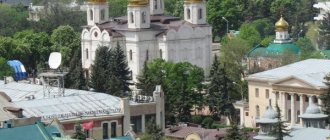Orel is a large city, which is located 360 km from Moscow.
A satellite map of Orel allows you to see that this settlement is located on the territory of the Central Russian Upland.
The map helps you quickly find all the necessary addresses in an unfamiliar city and navigate the confusing streets well. The map is considered a faithful assistant on any trip. With its help, you can calculate the distance to any object and calculate the time it will take to travel. In addition, it helps to choose the most convenient routes and bypass roads.
Yandex maps of Orel show that the city occupies both banks of the Oka River, as well as its tributary Orlik.
Where is Orel?
Orel is the administrative center of the Oryol region and the Oryol district.
It is a city of regional significance. The distance to Moscow is 360 km (to the southwest). Orel is located on the Central Russian Upland in the European part of the Russian Federation. The city stands on the left and right banks of the Oka River and its tributary Orlik. The approximate population of Orel is 315 thousand people, the total area of the city is 121 square kilometers. The climate in Orel is temperate continental: the first half of winter is milder than the second. The annual precipitation rate is 607 mm. In the southern part of the city there is Lake Bright Life. Most of the lakes and ponds are concentrated in the northern part of the city. The city of Orel and the region are part of the Central Federal District and the Central Economic Region.
Oryol is located in the same time zone as Moscow, the offset relative to Coordinated Universal Time (UTC) is +3.
Eagle families
Eagle Families
Eagles are very faithful birds; they mate for life. Some ornithologists discovered a pair of eagles that had lived together for more than thirty-five years.
Interesting: Armadillos - description, habitat, food, enemies, photos and videos
These birds have a wonderful organization of life. When the chicks are still very young, the parents share family functions. The male becomes the breadwinner, and the mother becomes the educator and nurse. She protects the nest and feeds the chicks, dividing the prey for them. Chicks usually hatch 1-2 per year. After 3 months they grow up and begin to fly to hunt on their own.
Sometimes, if the eaglet does not dare to leave the nest, the parent sits in front of the nest with the prey and begins to call the timid child.
Oryol Airport
In the city of Orel there is the Orel-Yuzhny airport, which was closed in 2010. The airfield was also excluded from the State Register of Civil Airfields of the Russian Federation. The distance from the city center to the airport is 6 km. The nearest international airport is in the city of Bryansk. The distance from Orel to the airport is 145 km. The airfield has the status of a federal facility.
Popular destinations of regular and charter flights: Krasnodar, St. Petersburg, Sochi, Antalya, Simferopol, Moscow, Anapa, Mineralnye Vody, Istanbul, Kaliningrad. The airport serves aircraft of major Russian airlines: S7 Airlines, Azimut, RoyalFlight, YAMAL, RusLine.
Chicks
Eagle chicks
When talking about chicks that are born in families of raptors, it is worth noting the following:
- The eggs are incubated primarily by the female eagle, but the male actively helps her in this, replacing her if necessary;
- Incubation of eggs lasts 40-45 days depending on the type of eagles;
- Also, depending on the type, the clutch may consist of 1-3 eggs;
- If the chick appears more than one, for the first 2 months there is a competitive struggle - the stronger one tries to get rid of its brother or sister. If this cannot be done within 2 months, peace reigns in the nest, the chicks no longer conflict;
- At 3 months, the parents' care for it stops, the chick is able to hunt on its own;
- Maturity comes to the mighty bird only at 4–5 years.
Train Station
The railway station in Orel is a junction station of the Moscow Railway, which is the center of the Orel-Kursk region of the Moscow Railway. Orel railway station is a 1st class local station. The number of tracks is more than 20, the number of platforms is 6. The opening date of the railway station is 1868. The railway station is located at Privokzalnaya Square, 1.
Popular long-distance train routes: Moscow, Kharkov, Belgorod, Stary Oskol, St. Petersburg, Krivoy Rog, Adler, Anapa, Lgov. Also at the railway station there is service for commuter trains that follow the following routes: Tula, Komarichi, Livny, Mikhailovsky Rudnik, Skuratovo, Verkhovye, Bryansk, Kursk, Yelets.
Natural habitats
The habitat of eagles is quite extensive, and each species has chosen unique territories for itself. It is worth noting that there is one feature: these places are located as far as possible from a person and his life activities. In this regard, eagles are found more often in mountainous areas or in semi-open landscapes.
If we take golden eagles, they live on the territory of our country, starting from the North Caucasus and ending with the southern regions of Primorye. For their nesting they choose hard-to-reach forest areas. Wedge-tailed golden eagles, which can be considered relatives of golden eagles, prefer to nest in forest plantations of New Guinea. Steppe eagles live in steppe zones, as well as semi-desert zones located between Transbaikalia and the Black Sea coast.
Imperial Eagles have long been found in the forest-steppe zones of Ukraine, in the steppes of Kazakhstan, in the forests of the Czech Republic, Romania and Spain. In addition, similar species of eagles live in the territories of Iran and China, Slovakia and Hungary, Germany and Greece, as well as other European countries.
Many peoples tame golden eagles and then use them in hunting as birds of prey.
Oryol bus stations
The bus station in Orel is located at st. Avtovokzalnaya, 1. The bus station building is located opposite the Sovremennik cinema. The bus station's operating hours are from 5:30 to 22:30, every day, without breaks. In the bus station building, passengers have access to a storage room for luggage and personal belongings, a spacious waiting room, a cafe, and a medical center.
Popular routes of regular buses: Baklanovo, Belgorod, Bashkatovo, Voronezh, Golokhvastovo, Dmitrovsk, Zheleznogorsk, Zalegoshch, Kaluga, Kiev, Krasnaya Zarya, Krivoy Rog, Krasnaya Roshcha, Lavrovo, Livny, Lipetsk, Mikhailovka, Moscow, Mokhovoye, Novodmitrovka, Ryazan, Smolensk, Tambov, Tula.
Features of reproduction
The breeding of eagles is closely related to the availability of food in the region. If they see that there is not enough prey to feed their offspring, they stop building nests and switch to a nomadic lifestyle, where all efforts are aimed at finding food. When there is enough food, predators begin to look for a partner in April - May. The nesting characteristics of these representatives of the class of birds depend on the habitat.
Mating and reproduction
Among the interesting information about the steppe eagle, it can be noted that these birds form a pair for life - this is typical for almost all accipitridines. Both parents have clearly divided responsibilities. The mating season begins immediately upon the arrival of predators from wintering grounds, when the last snow melts. In the south this happens in mid-late March, in the northern zones - closer to the beginning of April.
The mating rituals of eagles consist of joint figure flights, games in the air, and displays of plumage. You can often hear the voices of these birds when they are trying to attract a partner or drive away a competitor.
After mating, the female lays 2-3 eggs. They are small, white with chaotic yellowish and brownish spots. The eagle incubates and protects the clutch, from which, after 1.5 months, grayish-white, helpless chicks covered with down appear. Their first plumage appears after 1-1.5 months, and full development ends after 4 years. The lifespan of an eagle in captivity is up to 48-50 years, but in natural conditions most individuals die much earlier.
Eagle nesting
Eagles are unpretentious when choosing a place for a nest. They make their home at the bases and ledges of rocks, among bushes, in the crowns of lonely trees, on earthen or sandy hills. If a predator lives near a populated area, it may choose a pile of garbage or scrap metal, a haystack, a destroyed building, or a power line support. The main conditions are good visibility of the surrounding area and the ability to freely fly up to the shelter from above.
Birds' nests are massive, up to 0.7−1 m in diameter. They try not to place it too high - the dwelling is built either on the ground or at a height of 1-2 meters. The materials used are branches, plant stems, dry grass, and bunches. Often, a predator brings there scraps of skins, bones, manure, pieces of paper and cardboard, wire and various small objects created by man.
If the nest is placed on the surface, then it consists of a litter of chaotically scattered branches and patches of grass. On trees and hills, structures appear more solid. As a rule, they are quite strong and can withstand bad weather and wind. The eagle renews its home every year, returning from another winter flight to warm countries.
Caring for offspring
Newly hatched eaglets are born helpless and vulnerable . Both parents are actively involved in the life of the chicks, ensuring their survival until maturity. The male obtains food by bringing the female and her cubs carcasses of gophers and other rodents. The mother of the family warms and hatches the children. The eagle and she-eagle actively protect the brood from any danger. This applies not only to the threat of attack by predators - for example, during hot weather, birds open their wings wide, creating shade for their offspring.
Steppe eagle chicks appear at some interval and are often of different ages. Competition for food arises between them, which is why the smallest and weakest younger individuals often die of hunger. In the first weeks of life, the female tears food for them, since the cubs themselves cannot do this. As soon as they grow up and learn to peck prey on their own, the mother joins the father in the hunt and together they feed the brood.
At the age of 60 days, the chicks learn to fly independently. By August, they leave the mother’s nest and begin to hunt on their own, but can remain within the nesting area for a long time. The size of the parents' territory depends on the characteristics of the site and the amount of food on it. In areas untouched by humans and rich in vegetation, where large populations of rodents are found, nests can be very close - 1 km from each other.
Automobile highways
Federal highways pass through Orel:
- M2 "Crimea" is a highway that has the status of an object of federal significance. It is part of the European route E105. The total length of the route is 720 km. The road originates in Moscow and passes through Tula, Belgorod, Orel, Kursk. The final point of the M-2 route is the state border with Ukraine. The road surface of the route is concrete and asphalt.
- P120 is a public highway of federal significance, the total length of which is 445 km. The route begins in the city of Orel and passes through Rudnya, Bryansk, Smolensk. The final point of the road is the state border with Belarus. The road surface of the route is concrete and asphalt.
- P119 is a federal highway with a total length of 395 km. The route starts in Orel and passes through Lipetsk, Livny, Yelets. The final point of the route is the M6 Caspian highway, Tambov region. The road surface is asphalt.
- P92 is a federal highway with a total length of 206 km. The highway passes through the following regions of Russia: Oryol region, Kaluga region, Tula region. The road surface of the route is gravel, asphalt.
- E105 is a European route that starts in the Norwegian city of Kirkenes and passes through Tver, Moscow, Petrozavodsk, St. Petersburg, Kharkov, Tula, Simferopol, Kursk, Belgorod, Veliky Novgorod, Zaporozhye. The final point of the European route E105 is Yalta.
External description
The bird's body is large in size. The length of the male's body from head to tail is about 73 cm. Females are larger - they reach 80 cm. The eagle weighs 2.7-5.4 kg, and females are noticeably more massive than males. This species has no other gender differences; the sex of an individual can often be determined only during nesting and mating games.
The wings of birds are wide, large, elongated and narrowed towards the end. Their length is about 62-65 cm, and the total span reaches 2.2 m - this size allows the predator to look majestic. During the flight, it hovers above the ground in a straight plane, spreading its wings parallel to the horizon and bending the tips downwards. Sometimes the eagle makes rare flaps to gain height. Its flight speed while soaring reaches 190-240 km/h, despite the apparent smoothness of its movements. The maximum lifting altitude of a bird is 7-9 km, which exceeds the average aircraft.
The predator has a long, flexible neck with a small oval head. It is decorated with a massive, specifically curved beak with a rich yellow wax and a dark tip. It is framed by a light border around the mouth. The bird's eyes are large, oval, deep brown with a black round pupil.
The legs of the steppe eagle are relatively long and large. They are covered with feathers up to the foot, topped with 4 yellow toes and sharp and curved black claws. One of them is opposed to the other three to make it easier for the hunter to grab and hold the prey. The lower part of the bird's body is slightly rounded, the tail is of medium length. Well-developed role control in flight, opening like a fan, providing smooth turns.
The color of an eagle's plumage changes throughout its life. In the first year of life, the chicks are brown-ocher or reddish in color with brown and black bright spots. Then the coloring gradually darkens, fully developing by the age of 4 years. Reaching maturity, the predator acquires a discreet and monotonous dark brown color of feathers.
The belly and chest of eagles are slightly lighter than the back. The wings and tail are brown. The tail feathers are covered with transverse gray or dark brown stripes that reach the body.
Some individuals have a small reddish spot on the back of the head. You can see all the nuances of color in pictures and photographs.
What is Orel famous for?
On the station square of the city there is a sculpture “Eagle the Jubilee”, which is considered one of the main symbols of the city of Orel. The monument was erected in 2016. The sculpture is made of bronze and represents an eagle perched on a globe.
In the central part of the city there is Lenin Street, a pedestrian street, which is the main walking area of Orel. The length of the street is 600 m. Former noble mansions, cafes, and administrative offices are located here. In 1919, a museum of fine arts opened in Orel. To date, more than 7 thousand exhibits have been collected here: sculptures, paintings, objects of decorative and applied art.
Also in the city there is the I. S. Turgenev Museum, which is dedicated to the great Russian writer. The museum was opened at the beginning of the 20th century. In the historical center of the city there is the I. A. Bunin Museum, where a collection of letters, books, documents, manuscripts and personal belongings of the writer is collected.
Hunting
Eagle Hunting
Eagles are effective at hunting. They do not kill unnecessary animals; they catch only for their own food and for their chicks. They mainly hunt small game.
Eagles not only obtain food on their own, but are also ready to engage in outright robbery. For example, they can take prey from a smaller bird of prey on the fly.
Eagles are excellent at hunting flying birds. They overtake the prey by surprise, because they hunt from such a height that the bird cannot see them. And then they dive at such a speed that the prey does not have time to notice them. The slow-motion footage of the eagle fighting with its prey in flight is interesting. An eagle can catch birds on the fly and carry the trophy further.
Interesting facts about the bird
- Eagles very often soar above the ground, but even during such a soar the bird is capable of reaching speeds of 190-240 km/h. The illusion of slow motion occurs due to the flight altitude - more than 700 meters. The eagle dives at speeds of up to 320 km/h.
- The eagle has very sharp vision with a wide range of vision. Each bird's eye focuses on two objects at once (for example, in a person - only on one), and visual acuity allows the bird to see a hare at a distance of more than 3 km. From the height of its flight, the eagle sees prey over an area of 11.5 km. It is interesting that the eyes of eagles are endowed with two eyelids: transparent and dense. Transparent eyelids protect the bird's eyes from strong winds, and the latter are necessary for sleeping.











